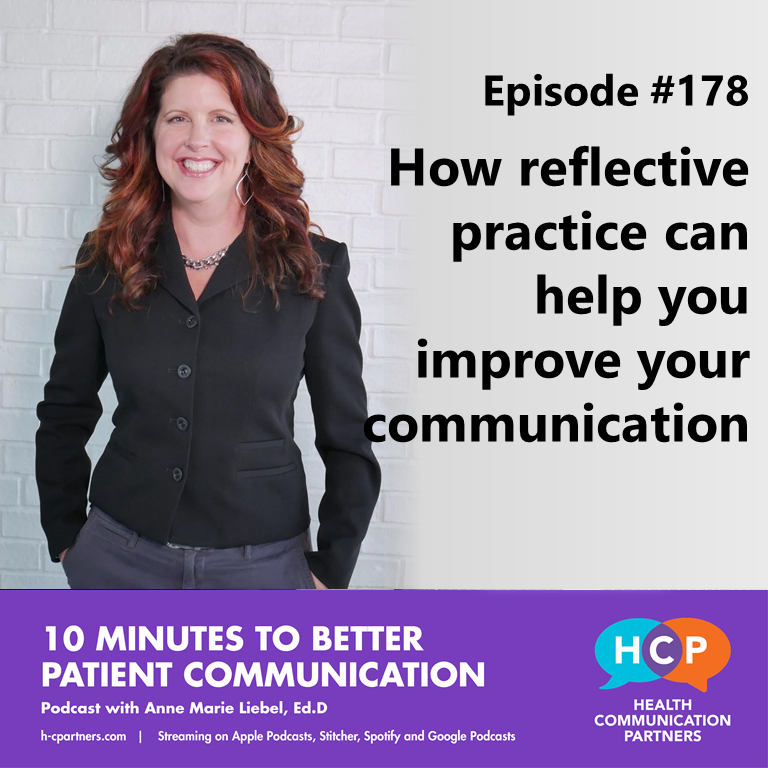Learn how reflective practice can help you improve your communication. Hear six examples of reflective practice on patient communication, along with something you can do today, to improve your communication.

You’re already good at patient communication. I know that because you’re listening to this show! So today’s episode is about how reflective practice can help you–Yes, you– improve your communication. I’m going to give you six examples of reflective practice on patient communication, and I’ll end with something you can do right now, today, to get even better at communication than you are right now.
Hi, Everybody, I’m Dr. Anne Marie Liebel for Health Communication Partners, and this is 10 Minutes to Better Patient Communication, recently ranked number 20 of the top 100 podcasts in the Social Sciences by Goodpods.
Yes, this episode is about reflective practice and what it can do for you. And I think people, sometimes when they hear reflective practice, they think it’s soft, they think it’s something that you just kind of do if you have spare time every once in a while.
And what I’m going to present to you is a very different picture, about reflective practice as a strategy, reflective practice as a technique, a process, an attitude, a stance. And I’m going to share six examples with you of people reflecting just like that on the problems that they are experiencing. Because whether it’s an interview or a monologue, this show takes up problems that are really problems, that real people like you in the health sector face. Not the problems I imagine you have, or the problems that I think, or someone thinks, you ought to have, but the problems and issues you tell me you have. That includes our guests, too.
Now this episode is running in June and so far this year, we’ve had six interview episodes–which is a lot for us. This show is mainly monologues. So it was super exciting for me that things turned out this way, where I got to have six interview episodes already this year.
I was blown away by our guests. And they are our six examples of reflective practice. I’m going to give you a quick flyover, to encourage you to listen to them or maybe give them a re -listen. And peel back a little bit of the layers about what’s going on in these interviews, so you can maybe get a little bit more out of them when you listen.
So we had some folks who are new to the show. We had Dr. Bradley Block, Dr. Erin Bassinger and Dr. Maggie Quinlan, and Dr. T.Q. Davis.
Bradley Block talked about efficiency in patient communication and really, who doesn’t think about that?! But he’s got interesting things to say. He takes it some places–he’s reflective about being efficient. Definitely check that out. Erin Bassinger and Maggie Quinlan research provider communication and anti -fat bias in the reproductive health context. This is a life and death issue for the people involved, so if you haven’t listened, definitely give that a listen. T.Q. Davis talks about the issue, it’s not really a problem, but it’s an issue, of when patients are making medical decisions, how their faith or religious backgrounds may come into their decision-making processes, and how important it is as public health professionals or medical professionals to be aware of this.
We also had some returning friends to the show, Dr. Ann Ancona, Dr. Ashley Love, and Dr. Jonas Attilus.
Ann Ancona is a nursing professor, and she talked about encouraging her students toward reflecting, toward being critical thinkers. So if that’s you, definitely listen to what Ann has to say. Ashley Love came to the show in May, which is both AAPI Heritage Month and Mental Health Awareness Month. She combined both of those topics, and talked about throughout her career how she has communicated with AAPI communities, as a member of those communities, about mental health. And Jonas Attilus was also talking about mental health as a psychiatry resident, and how he takes a learner’s stance when he interacts with his patients, and how this helps him give compassionate care. So I’ll go ahead and put links to each of those episodes in the show notes.
Each of those practitioners chose the problem or issue that they wanted to reflect on. And these are real problems in the field. That is what reflective practice really has going for it. The way that I practice it is that we look straight at reality. We are talking about the real problems that you have. So every one of them is addressing problems and issues in patient communication. Every one of them is reflecting, right? They’re brave enough to reflect out loud, with me right? Another person! Then they let us all kind of eavesdrop on that reflecting. And it’s so great and helpful to hear how other people think, right? You get to hear them describe how they work, what’s going through their heads.
And they’re doing such great work and such difficult work–like you do, work that defies simple solutions. Which again, this is where reflective practice as a strategy is so key. They’re all dealing with different problems, different issues, they’re knocking themselves out. They’re keeping going. They’re very good at their jobs, like you are, and they want to keep getting better, but in ways that matter to them. And that’s why they’re drawn to this show, I hope that’s why you’re drawn to this show, because that’s what reflective practice helps us to–really press into issues in a way that matters to us.
It’s refreshing, I think, to hear people being thoughtful, and wrestling with important contextual elements. There are nuances to their stories. They’re a kind of antidote to a lot of the, I don’t know, neat and tidy narratives flying around. My students used to call them sunshine-and-rainbow stories, “Everything’s great.”
What these people are not doing is important too, as part of the way that I practice reflective practice, and part of what I invite in other people. They’re not saying, “you should do this like me.” They’re inviting us to learn from their reflection. They’re not jumping to conclusions. They’re not reaching for quick fixes. They’re not sweeping things under the rug.
They’re looking hard at reality. This is what reflective practice supports. It’s generous of them to let us into their day-to-day in this way.
And it’s brave to be vulnerable, because I’m not giving them a neat narrative saying, “Tell us how you solved it so we can all be like you!” I’m not asking them to pretend to have certainty about something, a neat, tidy answer, if they don’t have it.
We all want to be better at our jobs. One of the things I have learned over the years is this. We all want to be better at our jobs. For a lot of us, working across sectors, working across industries, I’ve noticed that for a lot of us, this means in one way or another we want to reach more people. What “reach” means is going to depend on your industry. We also want to be better with the ones we’re already with.
Also, most of us want to support the missions of our organizations. a lot of those organizations want to have positive engagement, positive experience, positive satisfaction– whether you’re talking about employees, clients, patients, other stakeholders, suppliers, again, depends on your industry. But over years of working with people like these, I have learned this is something that we are all reaching for.
I said I would end with something you could do right now to improve your own communication. What is it? Well, if you’ve listened to any of my interviews, you’ve heard it. But have you tried it yourself?
It’s my four questions. I always ask our guests the same four questions in any of the interviews. It might be worded a little bit differently, but these questions are because this series is based on addressing problems, real problems, that real people face. So I asked the guest: what is a problem or an issue in patient communication or patient education that you are facing? How have you been facing it? What are you learning from facing it this way? And what are your next steps? Or, do you have any advice for folks facing a similar issue? That’s it.
What is the problem or issue that you’re facing? How are you facing it? What are you learning from facing it in this way? And what’s next for you?
I’m inviting you now to ask these questions of yourself, and answer them, honestly, to yourself. Don’t change the questions! these are powerful tools in reflective practice they’re designed to get below the surface. And they’re part of why the interviews are what they are, because people do take up these questions. and they answer them honestly for themselves, sometimes for the first time, on air with me. and we get to hear them.
And this gives you a taste of what it’s like to work with me. And with BRIDGES. BRIDGES is the name of my continuous improvement process that uses reflective practice.
Everyone knows about continuous improvement processes like Agile and Lean. BRIDGES, you know about, if you’ve been listening to this show for a while. I talked about BRIDGES on air, I think last, right before COVID. So I figured it was time that I brought it back up again. But if you get our newsletter, you know our newsletter is called BRIDGES. If you don’t get our newsletter, message me on linked or visit healthcommunicationpartners.com and sign up for it.
BRIDGES is an iterative approach that helps you break down and analyze your existing patient communication or patient education. There’s seven dimensions I evaluate you on. We look for strengths, obstacles, and opportunities so you can make sustainable change over time.
And we use this continuous process to help organizations in patient communication, in patient education, because they’re cross -cutting, right? These touch everybody. These touch all business processes. So, also helpful for you personally, and for your organization if they’re concerned with engagement, experience, and satisfaction.
For you, it can change the way you communicate, the way you educate, the way you think about these things, so you can get even better at what you do, in ways that matter to you. For more information, visit healthcommunicationpartners .com or message me on LinkedIn.
This has been “10 Minutes to Better Patient Communication” from Health Communication Partners. Audio Engineering and Music by Joe Liebel. Additional Music from Alexis Rounds.
